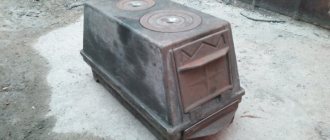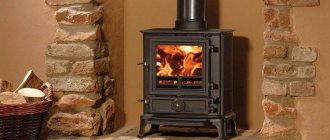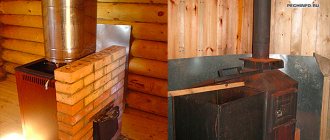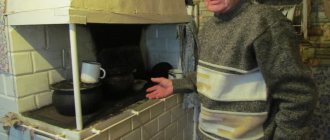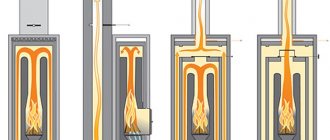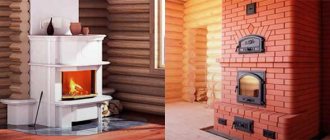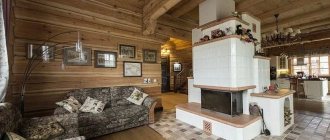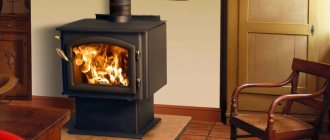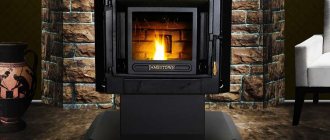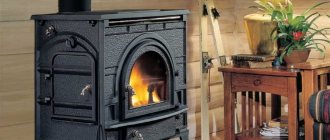This article will talk about wood and coal-fired convection stoves, which are used for heating private houses, urban or suburban, and country houses.
It’s worth mentioning right away that convection ovens, like any other type of generator, have their pros and cons. As you know, nothing ideal in terms of heating a room has ever been invented by man. If you do not take into account the advertising brochures of the manufacturers themselves, then the invention of an ideal heat generator is a matter of the future, although perhaps not too far away.
Design and principle of operation
The convection heating stove first appeared in Canada, the very first models looked like small portable convectors that could supply heat to a 100 m³ room in just 20 minutes. They were originally intended for lumberjacks who had to work outside in very cold temperatures.
This design of the stove allows you to heat the room in a very short period of time, while consuming very little fuel.
A convection oven for home looks like a metal structure in the shape of a cylinder. There are pipes welded into its body that are directed up and down.
The principle of operation of such a device is that the air, which is heated from the body, moves upward through the pipes, and the cold air is sucked from the floor by the lower pipes. Thus, air masses constantly and continuously circulate in the room.
The main structural elements of a convection oven are:
- a furnace in which fuel burns;
- ash pan: in this area the combustion product (ash) is collected;
- grate: a metal grate designed to hold coals;
- chimney: combustion products are discharged through it.
A hot air stream flows from the pipes, the temperature of which reaches +150°C.
Construction of a convector oven Termofor Valerian
The air temperature can be adjusted using a special power regulator. This is very convenient when using convection ovens to heat a house that is already well insulated and you just need to maintain the desired temperature.
The convection oven can operate in “instant heating” mode to maintain optimal temperature conditions.
Modes are changed using special dampers.
With one stack of wood, the stove can heat a house for 12 hours.
Thus, a convection oven for a summer house, home, garage and other premises is distinguished by its ability to heat air in a short time and maintain a set temperature for a long time, while consuming little fuel. Can work on wood, coal, peat, paper.
You can read about convector models of Termofor stoves here.
Differences from the oven
A convection oven will provide you with a guarantee of consistently high quality cooking. Unlike an oven, such a device is equipped with built-in fans and has a specific arrangement of heating elements: while in an oven they are installed at the bottom and top, in an oven - along the entire perimeter. When the heaters are activated, the convectors also turn on, distributing the heat flows so that they envelop the dish from all sides.
Convection ovens reduce cooking time by 25%, which has a beneficial effect on energy consumption. You can cook dishes in them on several levels at once - the result on the top and bottom will always be identical without unnecessary manipulations or rearrangements. A number of models are equipped with a steam generator, which, on the one hand, ensures effective rise of the dough, and on the other, prevents the crust from drying out.
Advantages and disadvantages of a convection oven
Wood-burning convection oven Teplodar TOP-140
Convection ovens are in great demand among users. And this is not surprising, because the many advantages that distinguish such designs justify this choice:
- Heat is distributed evenly throughout the room.
- Such units are highly economical.
- They can even work on wood and paper waste.
- Convection ovens are characterized by high productivity: efficiency reaches 80-90%.
- It is possible to adjust combustion modes.
- A large selection of products of various shapes and capacities, so you can choose a heating device for different-sized rooms.
- Long service life.
Despite the large number of advantages of such a system, there are also a number of disadvantages:
- During operation, hazardous combustion products are formed and released.
- During the installation process, you may encounter difficulties, because a prerequisite is permission from the fire department.
- When a convection oven operates, ash is released through the chimney, which undoubtedly pollutes the environment.
The disadvantages that convection ovens have must be taken into account when choosing a heating unit.
Buy original equipment
The online store offers you a wide range of original SMEG products for equipping a modern kitchen. In our catalog you will find:
- hobs;
- ovens;
- kitchen stoves;
- hoods;
- microwaves;
- refrigerators;
- dishwashers;
- washing machines.
We also provide a large selection of small household appliances: juicers, coffee machines, coffee grinders, kettles, blenders, mixers and toasters. For owners of small and medium-sized businesses, it will be relevant to purchase professional equipment - vacuum decanters, electric ovens, as well as cabinets for storing wine, blast freezing and proofing dough. In addition to them, you can purchase high-quality sanitary ware, dishes, accessories and cleaning products.
All equipment comes with a 24 month manufacturer's warranty. You can order any item OnLine - to do this, you need to add the selected model to the cart, fill out a form with contact information and generate an application. Our manager will contact you to clarify all the details of the transaction. Residents of Moscow and the Moscow region, as well as St. Petersburg and the Leningrad region, are provided with a courier delivery service. Parcels to the regions are sent by an independent transport company of the buyer's choice.
Varieties
The main criteria on the basis of which convector stoves for heating a dacha, home, etc. are differentiated. - this is the material of manufacture.
In this regard, the following are distinguished: metal, cast iron, brick stoves.
The first are constructed of high-strength steel that can withstand high temperatures. Such an installation heats the room in the shortest possible time. However, due to the fact that the metal layers are very thin, the heat also disappears quickly. For greater effect, stainless steel is used. Another disadvantage of a metal stove is that if the seams are made poorly, they may come apart under strong heating.
Cast iron ones have proven themselves well. They are compact in size and can take up any space in the house. A chimney is mounted on such a structure, which goes out onto the street, and it is through it that combustion products are discharged.
Brick kilns have gained the greatest popularity and have been able to gain the trust of users. Of all the varieties, they are the most durable and reliable. The chimney is made in the form of a coil. Thanks to this, combustion products, which are a source of heat, are efficiently preserved. A similar convection oven for heating a house heats up quite slowly, but the brick itself has the ability to retain heat for a long time. Such structures are multifunctional; they can be used to cook food and also be used as a fireplace.
Convection oven for heating in the interior
Possibility of fine adjustment of heating modes
It is very easy to regulate the combustion process and temperature level in such stoves. For this purpose, the design of the furnace provides special regulators, with the help of which the heater can be switched from the active combustion mode to the “smoldering” or “long-term burning” mode. Having filled the room with heat from the intense combustion phase, the user can switch the stove to the “smoldering” mode with one movement of the hand, ensuring quiet burning of wood and coals for long hours, during which the stove will maintain a comfortable air temperature. This mode is very convenient for the night, as well as, for example, for a bath. Maintaining all the same functions as a home stove, convector sauna stoves quickly warm up the steam room, and after switching to long-burning mode, they maintain the desired level of air temperature during bath procedures and after.
Often ovens operating on the convection principle have several chambers. The first chamber is responsible for the combustion of wood, and the second is responsible for the clean combustion of the released flue gases. Thus, to generate heat, the stove uses the energy of not only wood, but also flue gases, providing both significant savings in user resources and better heat transfer without harming the environment.
Features of choosing a convection oven
As already noted, stoves operating on the convection principle are multifunctional and suitable for any purpose related to space heating. However, for example, a residential building and a country house are two completely different environments, each of which requires a personal approach to choosing a stove.
It is important to take into account temperature changes; therefore, heating the stove more or less depends on each specific situation. Therefore, when choosing wood-burning convector stoves for your cottage or home, you need to consider the following:
- it is important that the stove can distribute heat evenly over 24 hours;
- the stove itself should also warm up evenly;
- outside temperature should vary between 90-95°C;
- with low fuel consumption, the temperature in the house should be stable;
- It is important to consider the size of the firebox, since the speed of the combustion process will depend on this indicator. The larger the firebox, the longer the heat will remain in the room;
- the stove must be free of cracks and visible damage;
- she must work for twenty years or more;
- appearance is also important; here, follow your personal preferences.
To summarize, convection ovens are a good alternative heat source that are easy to use and highly efficient. Such designs are in great demand among users and have many positive reviews.
Models for home and business
Leading manufacturers of household appliances offer a wide range of electric ovens for both home and business. The first ones are distinguished by modest dimensions and a basic set of functions - only what is necessary and nothing “extra”. The latter have expanded functionality that allows you to prepare dishes with different effects. In a professional oven you can easily heat up the finished dish, cook bread, buns, pies, biscuits and even grilled chicken! This technique is recommended as the main heating equipment for trade and catering establishments with a small and medium flow of customers, as well as as an auxiliary unit in establishments with a large number of guests.
Conclusions and useful video on the topic
An example of using a wood stove in a country house:
Design features of cast iron products:
Comparative review of Berezka and Vesuvius stoves:
Modern wood stoves have excellent functionality and serve as an effective source of heat not only for dachas, but also for cottages.
However, with all their advantages, we should not forget that wood is a renewable resource, and logging harms the environment. In addition, wood heating has an efficiency of no higher than 80% and quickly pollutes the chimney with soot and soot.
Are you choosing a wood stove for home use and want to consult with other users who have experience in operating similar heating devices? Ask your questions in the block below the article - our experts and other site visitors will try to help you.
If you use one of the stove models mentioned in our rating, please write your opinion about it, indicate the disadvantages you noticed during operation, as well as the main advantages, in your opinion.
Wood stove prices
The secret to the popularity of wood-burning stoves lies in their wide capabilities and variety of offerings. On the market you can find both budget compact options and luxurious units that can decorate the most sophisticated interior. No matter how charming a stove may be, constantly throwing firewood into the firebox is a boring task, which is why more and more owners of country cottages prefer long-burning stoves.
A modern version of a traditional way of heating a homeSource savoie-mont-blanc.com
If you look at average prices (in the Moscow region), they will look like this:
- Metal stoves. Heating: 5-16 thousand rubles. (depending on design). Heating and cooking: 9-35 thousand rubles. (domestic and imported). Stove-fireplace: 20-40 thousand rubles. (may have a stove and heat exchanger).
- Cast iron: From 20 to 120 thousand rubles, depending on the size and design.
- Stoves lined with tiles (tiles): 50-80 thousand rubles.
- Stone (from granite to Brazilian sandstone): 60-200 thousand rubles.
- With a water circuit: 20-55 thousand rubles.
- Long-burning stoves: 15-45 thousand rubles.
- Potbelly stove: 9-16 thousand rubles.
Conclusion
A high-quality home convection oven can be used both to heat a room and to cook food on a special panel. At the same time, a household convection oven has significant differences from one intended for industrial use. Household heating can heat up to 100 cubic meters. In rare cases, options up to 600 cubic meters are purchased, but this is only relevant for large private houses.
There is also a separate type of combi oven in which food is prepared. This is a common technique for restaurants, but the principle of steam generation in it is the same as in standard ovens of this design. Before making a choice, you need to take into account your needs and the dimensions of the device, as well as determine the location for its installation.
Additional equipment, expanded functionality
Increasing the operating comfort of such stoves is often achieved through additional functions and equipment. For example, such as:
- hob for cooking or heating food
- pipes for distributing hot air to adjacent rooms
- hydraulic circuit for water heating and operation of the hot water supply system (hot water supply)
- remote control
- automatic ash discharge
- non-heating combustion mode regulators and handles for safe opening of the combustion chamber
How to choose?
To choose a quality device, you need to decide on your needs and pay attention to the option that best suits them.
For a summer residence, it is recommended to choose solutions that have a surface for heating food. For home use in small spaces, electric options are the best. They will be a mini oven with convection.
When purchasing, you should pay attention to such indicators as:
- power;
- dimensions;
- material of manufacture;
- presence of a hob;
- installation safety;
- fuel used.
Models for home
- Flames KP-2. This stove has small dimensions, its weight is only 44 kg and there is a 40 liter combustion chamber. It is suitable for use in cabins, because it helps to uniformly heat the room.
- Flames KP-4. This oven is slightly larger in size. It has a power of 4 kW, so it can be used for medium-sized rooms. It has a simple design and attractive appearance.
- Furnaces of Professor Butakov. This option is suitable for heating your own home. It can be installed in the basement. The design works with solid fuel and consumes very little of it.
- Teplodar Matrix 100. This design has the advantage of being compact. At the same time, it can quickly heat about 100 cubic meters of area. It has a glass heat-resistant door and a two-channel afterburning system.
- Heater 100. There are also smaller models, so you should choose the appropriate option based on your needs. This stove can heat up to 100 cubic meters. The body is made of hardened steel. Best suited for household use.
Species and types
The operating principle of such furnaces is the same, but there are several types of this design, which differ from each other in a number of characteristics.
Firebox type
- Wood-burning (solid fuel). If this is a brick version, then it is a fairly large structure that is laid out in houses on a separate foundation. Their design initially includes convection channels next to the firebox. Essentially, an empty space and a hole at the bottom are left around the firebox, through which cold air will be drawn in. If these are metal structures, then they will not have much weight and require the installation of a foundation. They are already completely ready, so the buyer only has to choose the appropriate option based on the thickness of the metal layer, as well as the dimensions of the structure.
- Gas. There are also two options available here. This can be a stationary convection oven for cooking and heating the room. It is installed in a selected location in the room in such a way as to heat the house. There is also an alternative option in the form of a special fireplace that can be installed in any room. This design runs on bottled gas, but it is also possible to connect a main gas pipeline to this structure.
- Electric convection oven. One of the most common stove options. They are also called electric convectors, which can heat a room very quickly and efficiently. The advantage of this type of design is the possibility of its transportation due to its compact dimensions and the presence of mains power.
Conclusion
Convection ovens are an excellent alternative heat source that are very easy to operate and very efficient. Such ovens are very popular on the market, so manufacturers have significantly expanded their variety and capabilities.
The basis of any heater is the process of heat release when burning fuel or heating a conductor, in which all the conditions are created for the occurrence of electric current in it. On these foundations, many models of various stoves are built, the individualization of which is ensured by various features. But the most important thing that personalizes each model is the useful energy output, defined as efficiency. That is, all design improvements are aimed at increasing, at fixed costs, the share of energy converted into heat and used to heat the room.
You can work on the task in several directions.
- Increased combustion intensity. This will increase the energy released per unit time, but the efficiency often decreases as fuel consumption increases.
- Long burning technology. It is based on reducing intensity by limiting air access. As a result, the share of the released heat can be increased.
- Increased heat transfer efficiency. Many developments are based on the idea that the quality of room heating can be improved due to more efficient heat transfer. Convector ovens operate in this direction.
